


 |
Greg's Guests in San Miguel |
 |
Eating Out in San Miguel Allende |
 |
Return to the Index for Our Mexico Trip |
During the couple of weeks that we were here in San Miguel, Fred and I, usually with Greg or some other houseguests along as well, walked around San Miguel for various reasons. Whether it was to get to the market to lay in supplies, or just to see a park or other local feature, each walk was an interesting outing in itself, and each revealed something different about the city of San Miguel.
August 8: The Hacienda El Santuario San Miguel de Allende Hotel and Bar
As it was very close by, and because Greg wanted us to see the hotel bar in particular, we walked a couple hundred feet south down our street (Aldama) to the Hacienda San Miguel. It is located in a group of three old house full of history that have been combined to create the hotel. One interesting thing about the hotel is that all the public rooms and the guest rooms are finely decorated with beautiful pieces of Mexican folk art from the states of Michoacán, Oaxaca, Chiapas and Guanajuato.
The centerpiece of the hotel is its imposing central courtyard and event venue, covered by an impressive stand of bougainvillea ad a huge cherimoya tree that fruits for much of the year.
 |
The courtyard is often used for guest functions, and quite a number of civil marriage ceremonies have been held here.
|
To view the slideshow, just click on the image at left and I will open the slideshow in a new window. In the slideshow, you can use the little arrows in the lower corners of each image to move from one to the next, and the index numbers in the upper left of each image will tell you where you are in the series. When you are finished looking at the pictures, just close the popup window.
A particularly interesting-decorated area of the hotel was its beautiful bar- "La Sanmiguelada". I have no idea why the walls were all painted the way they were, but if you just look at some of the pictures below, you will see what I mean:
|
August 8: The Rosewood Hotel and Luna Rooftop Restaurant
On the very first day we were here in San Miguel, we arrived too late at Casa Pina for either breakfast or lunch, so in the evening on that first day, after we'd met Greg's current guests (Richard and Penny; Mohamed and Chase), Greg, Mohamed, Chase, Fred, and I went out for a walk in the afternoon, intending to find a place to have a light supper.
|
Many consider Luna to have the best views; they are certainly expansive, featuring unobstructed views of the city's beautiful skyline. We got a table and some snacks, and took lots and lots of pictures (not realizing this would be far from our only chance to do so from various rooftops.
Here is a classic view of the centro, with the spires of the Parroquia featuring prominently just to the right of center.
 |
|
The colors and ever-changing light of the city below offered different opportunities every few minutes to get a picture in a different light.
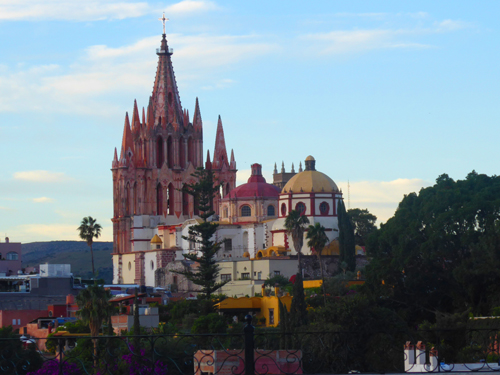 |
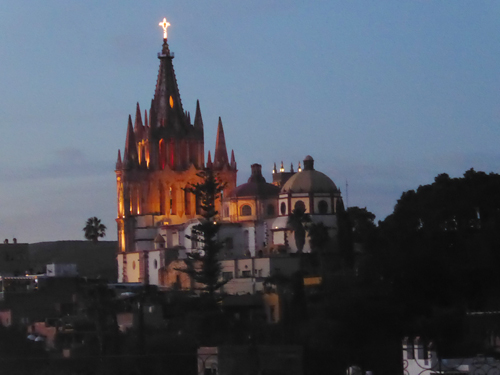 |
This was a great place to watch the sunset and take in the fading lights across the city’s palette of burnt sienna, earthy pink, and warm yellow hues in the sweeping views of the city’s iconic Parroquia de San Miguel Arcángel, bell towers, rolling hills, and beyond. Here are a selection of other pictures taken from Luna:
|
August 9: A Neighborhood Walk
On our second day here, we all (Greg, Richard and Penny, Mohamed and Chase, and Fred and I) decided to walk from Casa Pina to the City Market (a large food store about a mile away).
|
Centro is criss-crossed with cobblestone streets, small parks, odd intersections, and house after house behind its obligatory wall along the street. That's one of the things that takes some getting used to: the streets all look very sterile and closed-in, as each side is lined with a seemingly unbroken wall, punctuated only by color changes, a very few windows, and doors every so often.
But San Miguel is only really interesting and beautiful behind these walls- and our own Casa Pina was an excellent case in point. Behind our own plain door is a beautiful, multi-building house, courtyard, and garden. And all of that is invisible from the street. This is very unlike even city houses in the States, where the quality, size, and characteristics of the residences (or commercial establishments) are all visible from the street.
So when you look at many of the pictures from this and the other walks we took, don't assume that San Miguel is uniformly boring; the complexity of the various structures is hidden from the casual passerby.
So, the seven of us left Casa Pina (8 Aldama) and headed down the narrow street to the south:
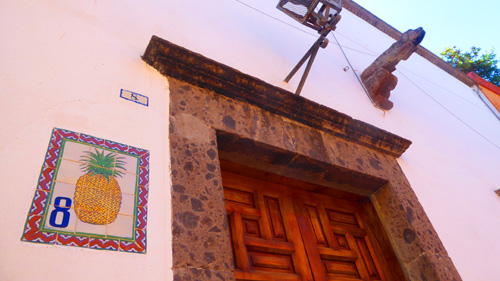 |
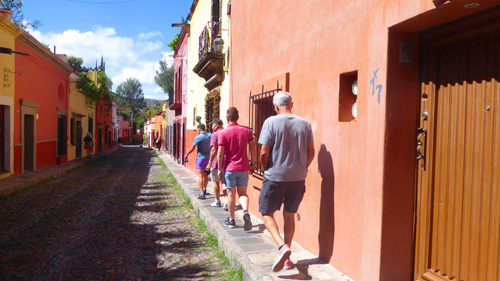 |
And just a short way down our street, Fred stopped to look back up the street and got this view of the Parroquia. He caught up with us as we continued down Aldama.
One of the things that stuck me about San Miguel was the color palette for almost all of the walls and, where we could see them, the houses. With only rare exceptions, the colors were all "earth tones"- ranging from brown and tan all the way to orange and red. Missing almost entirely were blues, yellows, and greens (save for the green vegetation and the occasional tile accent). But even within that fairly narrow palette, there was a great deal of variety.
|
|
|
You should use the movie player at right to walk up the street with us.
As for the rest of the pictures we took on this particular walk, we had three photographers- Mohamed, Fred, and I- who contributed pictures to the collection, and so there were some duplicates. Even so, there were quite a few good pictures left, interesting for one reason or another.
|
To view the slideshow, just click on the image at left and I will open the slideshow in a new window. In the slideshow, you can use the little arrows in the lower corners of each image to move from one to the next, and the index numbers in the upper left of each image will tell you where you are in the series. When you are finished looking at the pictures, just close the popup window.
August 10: A Visit to Iglesia San Francisco
On one morning of our first week here, Fred, Greg, and I were walking around the Centro just a block or so northeast of the square (Jardin Allende and the Parroquia) and we came across this church, set back from San Francisco street (the street was named for the church, not the other way around) with a park shaded by sculpted trees in front.
|
This style, while "in style" when construction on the church began, was, to put it mildly, excessive- particularly insofar as external ornamentation was concerned. Churches (and buildings) of this style were often completely covered with carvings, bas-relief, and other ornamentation.
Sadly, while the church of San Francisco was state-of-the-art for late 17th century central Mexican religious design, design is always a moving target, given that styles in Spain and Mexico City didn't stay the same. That was going to mean quite a bit for San Miguel's Church of Saint Francis.
This church wa built in the 20 years ending in 1799, and it was originally to be dedicated to and named for Saint Anthony. Saint Anthony was something of a role model for the new central-Mexican elites; he had been a rich man before he entered the Franciscan Order, and it was the well-to-do of San Miguel el Grande who paid to build this church.
Before we go into the church, we should talk a bit more about this "Churrigueresque" style. What was it all about, and what did buildings (particularly churches) in the style look like?
|
This is what the "Churrigueresque" style was all about, but as it turned out, the Saint the church was dedicated to, Saint Anthony, is also the patron of lost causes, which worked out well for this church as the architectural decoration style displayed here was about to become a lost art as the Spanish and Mexico city authorities declared the Churrigueresque to be passé. Unfortunately, San Francisco was in the process of being built.
What did get built using the Spanish Baroque decorative style Churrigueresque was the facade (the one in the scrollable window above) with its six terra-cotta like columns (called estipites) which ascend the entire height of the building. Like good Baroque, this facade "surprises" by contrasting the simple block frame of the sides with the explosion of saints and other stone carvings in the symmetrical center. This style was way over the top, but that seemed to be the point.
Actually, the ornamentation on the facade is extremely interesting, and there is a lot to see if you scroll around the whole picture at left. For example, the ornamentation around the central window depicts Saint Francis and (probably) Saint Anthony underneath the Crucifixion scene. This window is a bit unusual in that it is pretty much rectangular. Most Churrigueresque facades would have a more rounded central window as the baroque did not like things simple. Above this window, Saint Francis's statue crowns all. Elsewhere, you can find Mary ascending into heaven after smashing the evil snakes (or whatever) with her feet; she is helped in her endeavor by four cherubs.
|
So what did Tresguerras do? Well, he finished the church in the neoclassical style coming into vogue. The problem was, putting this style right next to the rococo Churrigueresque of the facade would have been too jarring. So what he did was build the tower in the neoclassical style but put it on a very simple base that did not detract from the obviously beautifully intricate carvings on the facade. For balance, he added a similar simple structure on the other side of the facade, although there was no tower atop it (as there are in most European churches).
To see clearly what he did, I've expanded a view of just the tower and its base, and that view is in the scrollable window at right. You can see clearly how the simple base reduces contrast, and how the style of the bell tower, while still fairly intricate, is not so close to the different style of the facade as to look so very much out of place.
So we have here a church in two styles, an occurrence that is probably not uncommon, given how long churches once took to build. The new, simpler style continued to influence Iglesia San Francisco with the addition of another structure to the left of the main facade.
|
It was built in 1713 but looks much older- like some of the early Franciscan churches in the New World which were used for both worship and defense. Members of the third order (the first and second were friars and nuns, respectively) were laymen of Spanish blood who did not live in religious congregations. They got to wear religious garb in their caskets (after they died).
One can only imagine that the position was sought after as a way of ensuring the member's avoidance of anything unpleasant in the afterlife. Beyond the bell tower is a monastery now fallen into decay. Members of the third order did NOT live here, of course, because as a secular order, they lived in the real world.
Before we go inside the church, I have a few more pictures taken outside that I think are worth including here.
|
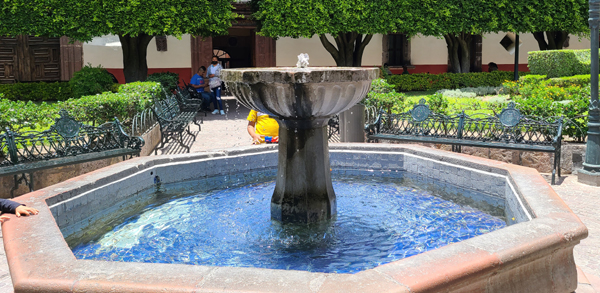 |
Finally, there was an interesting sign detailing some of the history of the Saint Francis religious ensemble, and I thought you might be interested in reading it. It is in the scrollable window below:
 |
Now let's go inside Iglesia San Francisco and see whether the Churrigueresque style permeated the interior, and whether the ornamentation inside the church matches that on the facade.
|
|
|
As you can see, on both sides of the church the architect lined the walls with Ionic columns. This was a neoclassic touch that would enhance the simplicity of the interior. The natural light comes from a dome with lightly-stained glass that allows natural light to filter softly down past the chandelier.
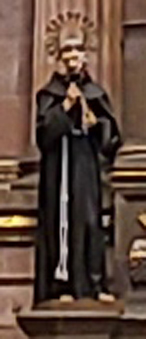 |
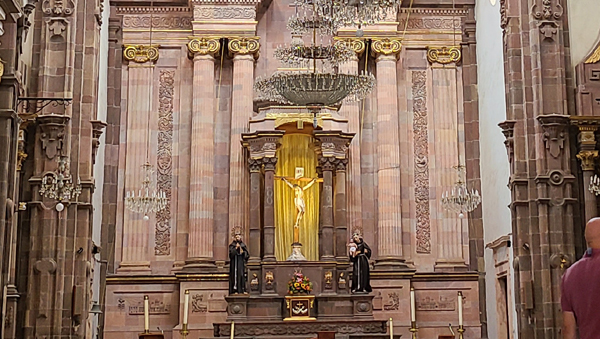 |
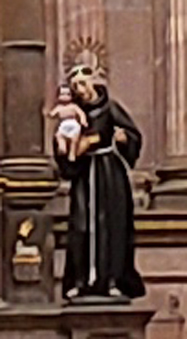 |
The main altar is the focal point of the church, and of course features a sculpture of the Crucifixion in the center. On the left, we find that Saint Anthony of Padua, for whom the church was originally named, is still honored by the statue on the right. Anthony is traditionally shown holding the Christ Child. The statue at left is of Saint Francis who eventually got naming rights here.
|
|
The altar to the right of the main one is the largest of many that line the walls of San Francisco. Note the tile floor and the religious art, much of it from the better local artists. This region has many tile and pottery factories.
|
|
|
|
The Church of San Francisco is a popular church in San Miguel de Allende, but the small park right in front of it is also usually filled with people sitting under the sculpted trees.
|
|
To the left of the park as you are walking to the front entrance of the church there is a cloister with a beautiful garden.
 |
August 11: A Driving Tour of San Miguel Allende
As part of our tour to the Atotonilco Folk Art Gallery, the Church of the Nazarene, and the La Gruta Spa, we were driven through areas of San Miguel that we were not able to walk to.
|
|
|
As for pictures, we took quite a few of those, and many of them turned out well, even though we were in motion when most of them were taken. They don't tell some sort of continuous story, but each one is interesting in one way or another. There were enough good ones that a slideshow became the most convenient way to include them in this album.
To view the slideshow of the pictures we took while driving in and around San Miguel, just click on the image at the upper left and I will open the slideshow in a new window. In the slideshow, you can use the little arrows in the lower corners of each image to move from one to the next, and the index numbers in the upper left of each image will tell you where you are in the series. When you are finished looking at the pictures, just close the popup window.
August 15: A Walk from Casa Pina to the City Market
We have walked to the City Market (local big grocery store) once already, but on this walk we tok a different route, and so saw some different things along the way.
|
|
An example are these three typical buildings framed nicely by the two big trees in front.
At one point, I came across an interesting (and large) building with a gated entrance, and the gate happened to be open. Looking inside, it seemed to be the courtyard of a large home, but here it was on a commercial street. Luckily, there was a sign nearby. I would have put the sign in a scrollable window for you to read, but there was a good deal of graffiti on the glass covering the signs, and so I will transcribe them here:
"The history of this property is closely linked to that of its owner, Manuel Tomas de la Canal y Bueno de Baeza, a Spanish creole native of Mexico City, who arrived at San Miguel el Grande village around 1730. This after having embarked on a real political and commercial career, as alderman and trader in Mexico City, owner in Queretaro city, supplier of meat and broker of the rich miners in Zacatecas and Guanajuato cities.
|
Towards 1743, when the primogeniture of the de la Canal was founded, this property was assessed with a value of 25,000 pesos, and it was described as a new house, orchard and adjoining plot, all protected by a stone and adobe rampart, that reached to the north part, in bounds with the brook called 'The Sprinkler.' At the front, there was also a huge vineyeard surrounded by a stone masonry enclosure, in a plot of one caballeria (over 100 acres), with good quality soil, composed of 8000 vines, and for irrigation a tank of 3 rods of depth (9 feet), 21 of length (52 feet) and 17 of width (43 feet); the ensemble was completed with a tannery.
Until the time when the textile mill was installed, the house was always inhabited by the family; however, in the face of the need to move its residence to the Main Square of San Miguel, it was necessary to find an economic profit to such an expensive residence, avoiding thus its ruin, as happened to those who were not inhabited. The size of the mill should had to have eight looms wide and two narrow, and it was described as, 'Free and earner people [who] go to work, and at their hours of eating and sleeping return to their homes...,' in such a way, it would be inhabited only by the administrator and butler. This mill strengthened the economy of the village by being one of the most productive in the region.
The location o fthis residence was privileged in the 18th century, being in the way from San Miguel to Chamacuero and Celaya, also, for its neighborhood with the important community of San Antonio de la Casa Colorada, which together with those who lived in the lands of the de la Canal, made a total of 65 families and about 500 inhabitants."
There was also a smaller sign advising that the buildings are now home to a remarkable school of the arts, incorporated to the University of Guanajuato and known as the "Allende Institute."
|
|
|
As I said, I am usually photographing anything and everything, but there has to be something of interest about the scene.
|
|
|
|
We were about halfway to City Market when we began hearing music and lots of noise. Almost immediately we could see that there was a parade coming north into San Miguel. It was obviously not impromptu, as there were police at the front of it directing traffic, motorcycle police at intervals along the parade, and police vehicles bringing up the rear. The parade was moving slowly, and taking up both northbound lanes, so the drivers behind it much have been a little pissed off.
|
|
What I did notice was that this was far from a solemn parade, with lots of folks just walking along in street clothes or whatever costumes they happened to have. I am pretty sure I saw Darth Vader at one point, and the last group in the parade was, inexplicably, a large group of mounted Mexican cowboys. Not caballeros in their traditional garb, but more like working cowboys from a ranch.
Anyway, I concluded that the good Padre had moved on, for I think if he had died the procession would have been much more restrained. I started my movie from the opposite side of the street, but when I could I crossed through the southbound traffic to film right alongside the parade as it passed by me. Use the movie player at left to watch some of this intersting parade.
|
|
|
|
August 18: A Crafts Fair at Jardin Allende
One Wednesday afternoon, we saw that lots of booths were being set up around two sides of Jardin Allende in front of the Parroquia, and the next day we found out it was a crafts fair.
|
I thought all the items were colorful and well-executed, so I photographed most of the vendor booths. There were way too many pictures to go the thumbnail route, so I have put them in a slideshow.
To view the slideshow, just click on the image at left and I will open the slideshow in a new window. In the slideshow, you can use the little arrows in the lower corners of each image to move from one to the next, and the index numbers in the upper left of each image will tell you where you are in the series. When you are finished looking at the pictures, just close the popup window.
Miscellaneous Pictures Taken Around San Miguel Allende
In this final section of pictures from our walks around San Miguel de Allende, I want to put some pictures that don't naturally belong anywhere else. They weren't take at some particular site we visited, or on a particular walk or tour that we made or took. No, they were just casual photos of anything and everything, but each of them has a quality that made me want to not discard them, but give them a place in the photo album. Some of the pictures have a common theme, and those will be grouped together.
The Doorways of San Miguel
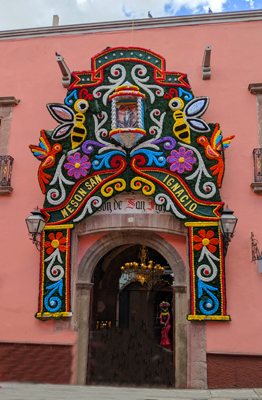 |
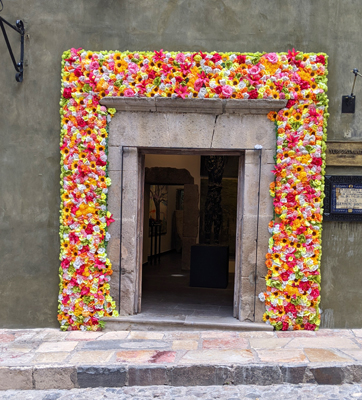
|  |
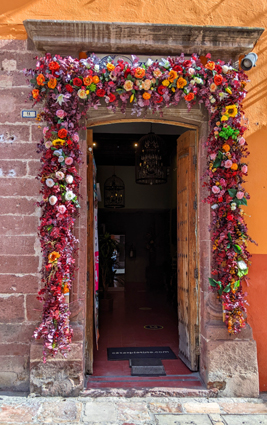 |
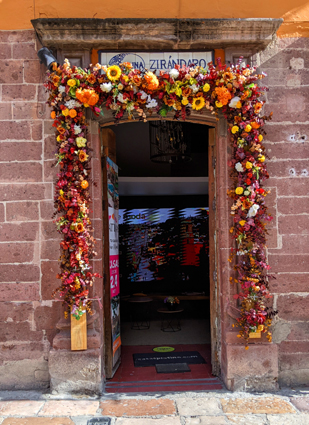
| 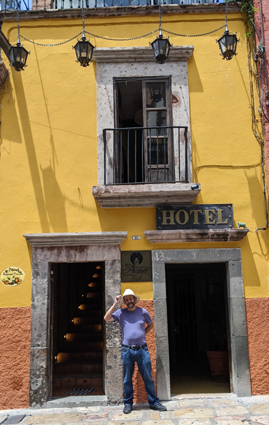 |
A Corner Park near Casa Pina
|
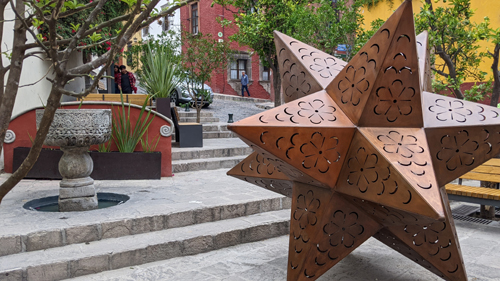 |
The little park had a few people sitting around, and the fountain was on, so it was a pleasant place to be. But the interesting thing was the large metal stellated dodecahedron sitting at one side of the park. Now, I would have thought that the geometrical shape would just have been someone's idea of an interesting sculpture to create, and the little arc-shaped holes all over the triangular flat surfaces of the star someone's idea of an interesting embellishment, but that was before I came back through this corner for the first time at night:
|
|
I discovered that the star had a high-intensity light inside, and at night, when it came on, the flower-shaped patterns made by the holes in the bronze played over the ground, the park, and the sides of the buildings all around. The effect was, as they say, magical.
Now, on our guided tour of San Miguel, and on many of our walks, we saw repetitions of this same shape being sold in big stores and small kiosks. I think you saw a picture I took in Atotonilco of all the sidewalk souvenir vendors, and all of them had multiple hanging copies of this same shape. This led me to think that the shape carried some significance here in Mexico, but I have searched diligently and cannot find any reference to either a religious or social significance.
Art Shops Just Off Jardin Allende
|
|
What I focused on in my photographs, however, were the amazingly colorful ceramic animals. Some of them depicted real animals:
|
|
and some of them depicted fake animals (I particularly liked the fake dog, and might have considered buying it, had not the price been well into the six digits. The price was in pesos, but even so, at twenty to the dollar...):
|
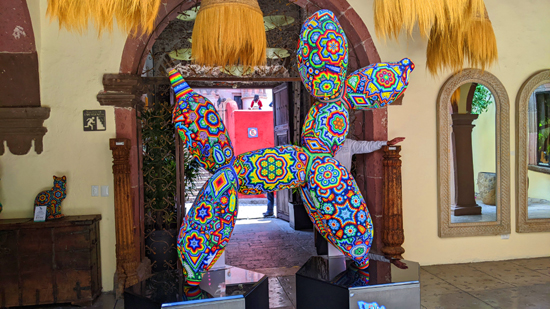 |
Looking Into an Art Gallery
|
|
Our Favorite Bakery
|
|
The Interesting, the Quirky, and the Beautiful
|
|
|
|
|
|
|
|
|
|
|
|
|
|
|
|
|
|
|
|
|
|
|
|
|
|
|
|
|
Well, I certainly hope you got a bit of the flavor of San Miguel from coming along on our various walks. It was immensely interesting for me just to stroll here and there; one could always find something interesting to take note of.
You can use the links below to continue to another photo album page.
 |
Greg's Guests in San Miguel |
 |
Eating Out in San Miguel Allende |
 |
Return to the Index for Our Mexico Trip |